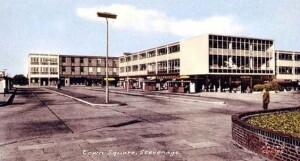 Over the years New Towns have received a bad press. They are regarded as too large and unwieldy in contrast to small, more intimate developments, such as Prince Charles’ Poundbury ( called by some Poundland) in Dorset and Cambourne in Cambridgshire. The last major New Town in England was probably Milton Keynes, which was begun in the sixties and took its inspiration from Stevenage New Town.
Over the years New Towns have received a bad press. They are regarded as too large and unwieldy in contrast to small, more intimate developments, such as Prince Charles’ Poundbury ( called by some Poundland) in Dorset and Cambourne in Cambridgshire. The last major New Town in England was probably Milton Keynes, which was begun in the sixties and took its inspiration from Stevenage New Town.
To the Mass Observation enthusiast George Hutchinson, the concept of building a New Town in the centre of the Hertfordshire countryside must have appeared distinctly exciting a year after the end of the Second World War. Clearly those who had been bombed out of such London suburbs as Walthamstow, Leyton, Edmonton and Tottenham needed to be properly re-housed in a part of rural England that was familiar to them. Instead of providing these Londoners with new housing in their locality, thus perpetuating the problem of insalubrious overcrowding and the overloading of urban transport systems (the car-owning generation was yet to develop), the planners envisaged new developments, close to old-established communities ,which were blessed with good existing transport systems, and with enough land that would provide for new industries, shops parks and houses with gardens. No longer would workers need to commute; everything would be provided within the boundaries of the New Town.
Government planners earmarked a number of these ‘satellite towns‘ that would surround London. Stevenage was to be the first of these. If it was a success, others would follow. However, no-one envisaged that the arrival of a bran new satellite town on the edge of a small community whose history went back six centuries was ever going to be received with enthusiasm by local residents. So when the Act of 1946 was eventually passed ( no local discussions in those days) Hutchinson took himself off to canvass opinion among the gardeners, tradesmen and householders that made up most of Stevenage’s 7,000 population.
Hutchinson began by asking a Mr Berry, Clerk of the Town Council, how many factories were likely to transfer their operations to the New Town. ‘ Plenty ‘ he was told. ‘ Plenty of individuals all over the country want to come too’, he added, ‘ and they all want to start as newsagents and tobacconists.’ Hutchinson was also informed that ‘ shopping arcades, swimming baths, schools, libraries, a museum, new cinemas, a theatre, sports’ grounds, churches, clinics, hospitals’ were earmarked too. ‘ The people will live in model houses, probably similar to many of those at Welwyn Garden City. Each home will have a good size garden, and parks, green belts, trees, will split the residence area up into attractive and not-too-sprawling groups—probably six, each containing about 10,000 people ‘.
Hutchinson must have expected some opposition to the scheme among the locals, but he found more than he expected. The middle-class Mr Poulton was one. He lived with his family in’ a large, pleasantly secluded bungalow’ with a large garden and orchard at the southern end of Stevenage, which he had bought in 1934.
‘ He fears that he may be forced to sell his home, and that in any case part of his land will be take away from him for new building sites. He thinks that he will be hemmed in on all sides. If this happens the spaciousness and tranquillity that attracted Mr Poulton—and many like him—to Stevenage will disappear.’
Hutchinson also met with similar fears from a middle-aged woman he called ‘Mrs Jones ‘.
‘People say it will spoil Stevenage. They won’t want to live here any more. Half of them have come away from built-up parts. People are more against it than for it. But the Government have made up their minds…’
But in local butcher R.A.Cook Hutchinson found a newcomer from Woodford who was all for the New Town. ‘I first saw Stevenage when I evacuated my wife and child here during the blitz’, he explained, ‘and here they stayed all through the war…I wouldn’t think of going back to London. It’s far better living here in the country, and I reckon they’re nicer people too…If the new place is decently done—not drab, depressing, everything alike, same as it is in Dagenham—it will be a fine thing.’
Hutchinson sent his article, which he titled ‘Stevenage: a New Design for Living’ to John Bull, a leading right wing magazine, but it wasn’t used. We don’t know if the piece ever appeared in print, but we do know that the New Town was built according to the specifications listed by Hutchinson, and that, it has been largely a success.[R.M.Healey]
